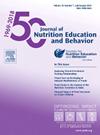不良童年经历、青春期家庭资产和成年期饮食行为:2010-2023年EAT研究结果
IF 2.3
3区 医学
Q2 EDUCATION, SCIENTIFIC DISCIPLINES
引用次数: 0
摘要
很少有研究探讨家庭资产如何缓冲不良童年经历(ace)和饮食失调之间的关系。目的本研究探讨(1)青春期家庭资产(高家庭功能和连通性,频繁和愉快的家庭用餐)的流行与ACE数量的关系;(2)ACE与成人饮食失调之间的关系如何根据家庭资产而变化。研究设计、环境、参与者这项饮食与活动随时间变化的研究招募了明尼阿波利斯-圣波利斯一所中学的青少年。2009-2010年在明尼苏达州的保罗。13年随访调查的受访者如果在8年随访调查中也完成了ACE测量,则纳入本分析。982名参与者(52%为女性,21%为亚洲人,25%为黑人,19%为西班牙裔,22%为白人)完成成人饮食行为测量时的平均年龄为27.6±2.0岁。可测量的结果/分析家庭资产测量作为基线调查的一部分完成,并在成年早期对六种形式的ace(如情绪虐待)进行回顾性评估。成人饮食行为评估的应对饮食、暴饮暴食和不健康体重控制行为(UWCBs)。采用Logistic回归模型,包括人口统计学协变量,估计青少年时期高资产环境(3+)和低资产环境(0-2)参与者的ACE数量。结果有一次或多次ACE的家庭高资产率为22%,而无ACE的家庭高资产率为31% (P=0.02)。对于低资产的参与者,ACE值与较高的饮食应对患病率相关(P<;0.001),暴食(P<;0.001)和uwcb (P=0.03)。例如,在低资产组中,没有ACE的人群暴食率为11%,1-2 ACE的人群为21%,3+ ACE的人群为28%。在高资产的参与者中,观察到的ace与行为流行之间的关系减弱。结论制定强化家庭资产的干预措施有助于改善ace成人的饮食行为。FundingNIH本文章由计算机程序翻译,如有差异,请以英文原文为准。
Adverse Childhood Experiences, Family Assets in Adolescence, and Eating Behaviors in Adulthood: EAT 2010-2023 Study Findings
Background
Few studies have explored how family assets may buffer the relationship between adverse childhood experiences (ACEs) and disordered eating.
Objective
This study examines (1) the family asset (high family functioning and connectedness, frequent and enjoyable family meals) prevalence during adolescence in relation to ACE number and (2) how the relationship between ACEs and adult disordered eating may vary according to family assets.
Study Design, Settings, Participants
The Eating and Activity over Time study enrolled adolescents who were attending a secondary school in Minneapolis-St. Paul, Minnesota in 2009-2010. Respondents to the 13-year follow-up survey were included in this analysis if they also completed ACE measures as part of the 8-year follow-up survey. The analytic sample of 982 participants (52% women, 21% Asian, 25% Black, 19% Hispanic, 22% White) had a mean age of 27.6±2.0 years when they completed adult eating behavior measures.
Measurable Outcome/Analysis
Family asset measures were completed as part of the baseline survey and six forms of ACEs (e.g., emotional abuse) were retrospectively assessed in early adulthood. Measures of adult eating behavior assessed for eating to cope, binge eating, and unhealthy weight control behaviors (UWCBs). Logistic regression models, including demographic covariates, were used to estimate behavior prevalence by ACE number among participants with high asset (3+) and low asset (0-2) environments during adolescence.
Results
The adjusted prevalence of high family assets was 22% among participants with one or more ACE compared to 31% among those with no ACE (P=0.02). For participants with low assets, ACE number was associated with a higher prevalence of eating to cope (P< 0.001), binge eating (P< 0.001), and UWCBs (P=0.03). For example, in the low asset group, the prevalence of binge eating was 11% among those with no ACE, 21% for 1-2 ACEs, and 28% for 3+ ACEs. The observed relationships between ACEs and behavior prevalence were attenuated among participants with high assets.
Conclusions
The development of interventions to strengthen family assets could benefit the eating behaviors of adults with ACEs.
Funding
NIH
求助全文
通过发布文献求助,成功后即可免费获取论文全文。
去求助
来源期刊
CiteScore
4.20
自引率
11.50%
发文量
379
审稿时长
44 days
期刊介绍:
The Journal of Nutrition Education and Behavior (JNEB), the official journal of the Society for Nutrition Education and Behavior, is a refereed, scientific periodical that serves as a global resource for all professionals with an interest in nutrition education; nutrition and physical activity behavior theories and intervention outcomes; complementary and alternative medicine related to nutrition behaviors; food environment; food, nutrition, and physical activity communication strategies including technology; nutrition-related economics; food safety education; and scholarship of learning related to these areas.
The purpose of JNEB is to document and disseminate original research and emerging issues and practices relevant to these areas worldwide. The Journal of Nutrition Education and Behavior welcomes evidence-based manuscripts that provide new insights and useful findings related to nutrition education research, practice and policy. The content areas of JNEB reflect the diverse interests in nutrition and physical activity related to public health, nutritional sciences, education, behavioral economics, family and consumer sciences, and eHealth, including the interests of community-based nutrition-practitioners. As the Society''s official journal, JNEB also includes policy statements, issue perspectives, position papers, and member communications.

 求助内容:
求助内容: 应助结果提醒方式:
应助结果提醒方式:


